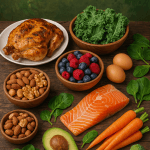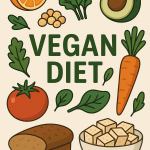Fatty liver disease affects nearly one in four adults worldwide—and many don’t even know they have it. Known in medical circles as non-alcoholic fatty liver disease (NAFLD), this condition silently builds up fat in the liver, often without noticeable symptoms, until it causes real damage. But there’s good news: fatty liver is completely reversible in most cases, especially when caught early.
In this medically-backed, step-by-step guide, you’ll learn 7 practical and doctor-approved strategies to heal your liver quickly and naturally. These aren’t fad diet tips or miracle cures—they are rooted in science and recommended by hepatologists and nutritionists who understand how your liver works.
Let’s dive into the steps that can transform your liver health and boost your overall wellness.
Understanding Fatty Liver Disease
Fatty liver disease happens when excess fat accumulates in liver cells, affecting your liver’s ability to perform key functions like filtering toxins, producing bile, regulating blood sugar, and managing cholesterol.
There are two main types:
- Alcoholic Fatty Liver Disease (AFLD) – caused by excessive alcohol intake.
- Non-Alcoholic Fatty Liver Disease (NAFLD) – driven primarily by poor diet, insulin resistance, and obesity.
Left untreated, NAFLD can progress to non-alcoholic steatohepatitis (NASH), then to fibrosis, cirrhosis, or even liver failure.
Early signs may include:
- Elevated liver enzymes (ALT, AST) in blood tests
- Fatigue and low energy
- Mild abdominal discomfort
- Brain fog
- Unexplained weight gain or belly fat
The key takeaway? Early detection means early reversal—so let’s look at how to take action right now.
Step 1: Overhaul Your Diet with Liver-Friendly Foods
Your diet is the #1 weapon in reversing fatty liver. By simply adjusting what you eat, you can reduce liver fat, improve liver enzyme levels, and boost overall function.
Eat more of these:
- Leafy greens: Spinach, kale, arugula—rich in chlorophyll, antioxidants, and fiber
- Cruciferous vegetables: Broccoli, cauliflower, Brussels sprouts support liver detox
- Healthy fats: Avocados, nuts, seeds, extra virgin olive oil
- Fatty fish: Salmon, mackerel, sardines—rich in omega-3s
- Whole grains: Oats, quinoa, brown rice (in moderation)
- Low-sugar fruits: Berries, grapefruit, green apples
- Herbs and spices: Garlic, turmeric, ginger (anti-inflammatory powerhouses)
Avoid or limit:
- Refined carbs: White bread, pastries, pasta
- Sugary drinks: Soda, sweet teas, energy drinks
- Fried foods: Especially from seed oils (soybean, corn, canola)
- Processed meats: Sausages, bacon, deli meats
- Alcohol: Even in small amounts, it burdens the liver
- High-fructose corn syrup: Common in soft drinks and packaged snacks
Quick tip: Focus on whole, minimally processed foods. Think Mediterranean-style meals with lots of color and texture.
Step 2: Lose Weight Safely and Sustainably
Excess body fat, especially around the abdomen, directly contributes to liver fat accumulation. Fortunately, losing just 5–10% of your total body weight can reduce liver fat by up to 40%.
But beware of crash diets or fasting extremes—these can trigger a dangerous spike in liver inflammation. Instead, aim to lose 1–2 pounds per week through:
- Calorie awareness (without starving yourself)
- Portion control
- Balanced macronutrients: Moderate carbs, high fiber, sufficient protein
- Healthy snacks: Nuts, fruit, hummus, hard-boiled eggs
The goal is fat loss, not muscle loss. Lean muscle helps you burn fat more efficiently, including in the liver.
Step 3: Move Your Body Every Day
Physical activity is a powerful tool to improve liver health. Studies show that aerobic exercise can reduce liver fat by 10–20% even without weight loss.
Recommended:
- 30 minutes of moderate-intensity exercise 5 times per week
(Brisk walking, cycling, swimming, dancing) - Strength training 2–3 times per week
(Bodyweight exercises, resistance bands, weights)
If you’re sedentary now, start small:
Even a 10-minute walk after meals improves insulin sensitivity and liver function.
Bonus tip: Stay active throughout the day—stand more, stretch, take the stairs, do house chores with enthusiasm. Every step matters to your liver.
Step 4: Balance Blood Sugar and Insulin Naturally
Insulin resistance is the silent driver of fatty liver. When your body can’t use insulin effectively, glucose builds up and is stored as fat—much of it in the liver.
Here’s how to regain control:
- Eat high-fiber carbs: Beans, lentils, berries, whole oats
- Combine carbs with protein and fat to slow digestion
- Avoid sugary snacks and drinks that spike blood sugar
- Try apple cider vinegar before high-carb meals (may improve insulin response)
- Fast overnight for 12–14 hours to give your liver time to reset
If you have type 2 diabetes or prediabetes, consult your doctor before making dietary changes or adjusting medication.
Step 5: Improve Sleep and Reduce Chronic Stress
The liver doesn’t just work while you’re awake—it heals during deep sleep. Chronic stress and sleep deprivation disrupt hormonal balance, spike cortisol, and worsen insulin resistance and liver inflammation.
To optimize:
- Sleep 7–9 hours per night
- Avoid screens 1 hour before bed
- Establish a sleep routine with consistent times
- Use stress-reducing techniques daily:
(Breathwork, journaling, meditation, nature walks, music, gratitude)
Mental calm = metabolic health. When you’re rested and relaxed, your liver functions at its peak.
Step 6: Use Targeted Supplements Wisely
Certain natural compounds can enhance liver repair and function, especially when combined with lifestyle changes.
Doctor-recommended supplements:
- Omega-3 fatty acids (EPA/DHA) – reduce inflammation and triglycerides
- Vitamin E – powerful antioxidant for liver cells (only under supervision)
- Milk thistle (silymarin) – supports regeneration of liver tissue
- NAC (N-acetylcysteine) – precursor to glutathione, the body’s master detoxifier
- Berberine – improves insulin sensitivity and glucose regulation
- Vitamin D3 – low levels linked to NAFLD progression
Always consult your doctor or registered dietitian before starting supplements—especially if you’re on medications or have other health conditions.
Step 7: Track Progress and Work with Your Doctor
Healing fatty liver isn’t guesswork—it’s measurable. Make sure you’re getting the right lab tests and imaging regularly to monitor liver health:
- Liver function tests (ALT, AST, GGT)
- Ultrasound or FibroScan for fat and fibrosis
- Lipid panel for cholesterol and triglycerides
- Fasting insulin and A1C for blood sugar regulation
- CRP and ferritin for inflammation markers
Ask your doctor to help set clear goals and check in every 3–6 months. Reversing fatty liver is a medical achievement worth tracking—and celebrating.
Doctor’s Tips for Everyday Liver Healing
Eat a high-fiber salad every day
Cook with olive oil—not vegetable oils
Stay hydrated (aim for 2–3 liters of water daily)
Try 20-minute walks after dinner
Use herbs like turmeric, cumin, and ginger liberally
Limit or eliminate alcohol until liver health is restored
Go to bed before midnight for optimal hormonal repair
Sample One-Day Meal Plan for Liver Health
Breakfast
Avocado toast on sprouted grain bread with poached egg
Green tea with lemon
Snack
Cucumber slices and hummus
Lunch
Grilled salmon bowl with quinoa, kale, red cabbage, and tahini dressing
Snack
Apple slices with almond butter
Dinner
Lentil stew with turmeric and garlic
Steamed broccoli and roasted carrots
Herbal chamomile tea
FAQs
Yes, especially in early stages. Through sustained dietary and lifestyle changes, many people experience complete reversal within 6–12 months.
Yes, when practiced safely. A 12–14 hour overnight fast allows the liver to reset and enhances insulin sensitivity.
Surprisingly good! Coffee (without sugar) has been shown to lower liver enzymes and reduce risk of fibrosis.
It’s best to avoid alcohol entirely until your liver is healed. Even small amounts can interfere with recovery.
Most cases respond to lifestyle changes alone. Some may require medication for blood sugar or lipids under doctor supervision.








Post a comment